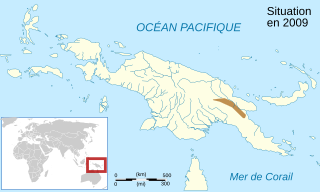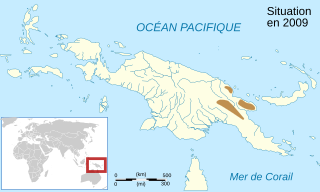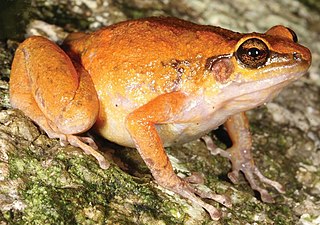Choerophryne sanguinopicta is a species of frogs in the family Microhylidae. It is endemic to southeastern Papua New Guinea and only known from the vicinity of its type locality, the northern slope of Mt. Simpson in the Owen Stanley Range, Milne Bay Province, although it is expected to occur more widely. The specific name sanguinopictus, from Latin for sanguis ("blood") and pictus ("painted") refers to the distinctive red blotching and punctations characteristic for this species.
Choerophryne variegata is a species of frog in the family Microhylidae. It is endemic to West Papua, Indonesia, and is only known with certainty from its type locality, Digul River. It is assumed that most records from elsewhere refer to other, possibly undescribed species. As the species is only known from one specimen from its vaguely stated type locality, its ecology is essentially unknown, although it is presumed to be a rainforest inhabitant. No other specimen has been collected anywhere near the type locality. Despite all this, vernacular name common rainforest frog has been coined for it.
Austrochaperina blumi is a species of frog in the family Microhylidae. It is endemic to New Guinea and known from the northern slopes of the New Guinean Central Range in Western New Guinea (Indonesia), and from the Bewani, Torricelli, and Hunstein Mountains in Papua New Guinea. The specific name blumi honors J. Paul Blum, the herpetologist who collected the type series. Common name Kosarek land frog has been proposed for it.
Barygenys exsul is a species of frog in the family Microhylidae. It is endemic to Papua New Guinea. It is known from Rossel and Sudest Islands in the Louisiade Archipelago, east of New Guinea. It is uncertain whether the specimens from Sudest really are conspecific with this species. Barygenys apodasta and Barygenys resima were mixed with this species prior to their description in 2013.
Callulops boettgeri, also known as Boettger's Callulops frog, is a species of frog in the family Microhylidae. It is endemic to Halmahera in the Maluku Islands of Indonesia. It is only known from the holotype collected from Galela in 1894. The genus-level placement of this little known frog has changed many times, and it is still unclear whether it should be placed in some other genus.
Cophixalus nubicola is a species of frog in the family Microhylidae. It is endemic to Papua New Guinea and only known from its type locality, Mount Michael in the Eastern Highlands Province. The specific name nubicola refers to its cloud-swept habitat. Common name Michael rainforest frog has been coined for this species.

Cophixalus parkeri is a species of frog in the family Microhylidae. It is endemic to Papua New Guinea where it occurs in the central mountainous region between Chimbu and Morobe Provinces. The specific name parkeri presumably honours Hampton Wildman Parker, an English zoologist and herpetologist to whose perusal Arthur Loveridge sent the holotype. Common name Papua rainforest frog has been coined for it.
Cophixalus pulchellus is a species of frog in the family Microhylidae. It is endemic to mainland Papua New Guinea and only known from its type locality in the Hunstein Mountains ; a northern offshoot of the Central Dividing Range. The specific name pulchellus is diminutive of Latin pulcher, meaning "beautiful".
Cophixalus riparius is a species of frog in the family Microhylidae. It is endemic to Papua New Guinea and occurs in the New Guinea Highlands in Madang, Southern Highlands, and Western Highlands provinces southeastward to the Morobe Province. The specific name riparius refers to the creek-side habitat from which many specimens in the type series were collected. Common name Wilhelm rainforest frog has been coined for this species.

Cophixalus shellyi is a species of frog in the family Microhylidae. It is endemic to Papua New Guinea and occurs in the New Guinea Highlands as well as in the Adelbert Range and on the Huon Peninsula. The specific name shellyi honors Father Otto Schellenberger ("Shelly"), an American missionary and former professor in mathematics who collected the type series.
Cophixalus tagulensis is a species of frog in the family Microhylidae. It is endemic to Papua New Guinea and only known from the Tagula Island in the Louisiade Archipelago, east of New Guinea. It is only known from the type series of three specimens collected in 1956.

Cophixalus zweifeli is a species of frog in the family Microhylidae. It is endemic to northern Queensland, Australia, and only known from the area of its type locality in the Cape Melville National Park. The species was named to honour American herpetologist Richard G. Zweifel. Common name Zweifel's frog has been coined for it. It is one of the five northeast Australian Cophixalus species that are specialized in boulder field habitats.
Xenorhina zweifeli is a species of frog in the family Microhylidae. It is endemic to New Guinea and is only known from the Bewani and Hunstein Mountains in northern Papua New Guinea. The species is named for American herpetologist Richard G. Zweifel, a specialist in New Guinean herpetology and microhylid frogs; he is also said to share "characteristically terse vocalizations" with this frog.
Xenorhina adisca is a species of frogs in the family Microhylidae. It is endemic to West Papua, Indonesia. It is only known from its type locality, Tembagapura, in the Sudirman Range. The specific name adisca refers to the absence of digital discs, a defining feature of the species.
Cophixalus timidus is a species of frog in the family Microhylidae. It is endemic to New Guinea and only known from the northern slope of Mount Simpson in the Milne Bay Province, southeastern Papua New Guinea.
Papurana grisea is a species of true frog. It is known with certainty only from its type locality in the Went Mountains, in the Indonesian province of Papua, New Guinea. Similar frogs are widespread in New Guinea, usually above 1,200 m (3,900 ft) above sea level, as well as on the Seram Island, but their identity is uncertain; they possibly represent another, undescribed species. Common names Went Mountains frog and Montaen swamp frog have been coined for it.
Hylophorbus proekes is a species of frog in the family Microhylidae. It is endemic to Papua New Guinea and only known from the vicinity of its type locality on the southern slope of Mount Sapau in the Torricelli Mountains, West Sepik Province.

Callulops omnistriatus is a species of frog in the family Microhylidae. It is endemic to Papua New Guinea and is known from the southern slope of the Central Highlands, Southern Highlands Province. The type locality is in the vicinity of the Moro Airport.
Callulops eremnosphax is a species of frog in the family Microhylidae. It is endemic to Papua New Guinea and only known from its type locality near Tekadu Airport in the Gulf Province. The specific name eremnosphax is derived from Greek eremnos meaning "dark" and sphax meaning "throat".
Sphenophryne magnitympanum is a species of frog in the family Microhylidae. It is endemic to Papua New Guinea and only known from the vicinity of its type locality on the western slope of Mount Obree, Central Province.





